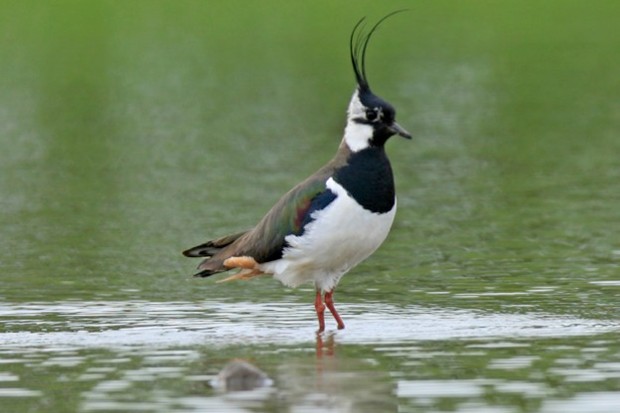.jpg)
Northern Lapwing: Large, unique plover with black breast, face, crown, and long upright head plumes; back is green-tinged purple and copper. Belly and sides are white, uppertail is white with a black tip, and undertail coverts are rich rufous-orange. Wings are dark with white tips; legs are pink. Sexes are similar. Winter adult shows less black on face and has white edges on dark back feathers. Juvenile resembles winter adult but has fine spots on dark back, and shorter head plumes.
Range and Habitat
Northern Lapwing: This species is found in a wide variety of open areas with bare ground or low grasses. It is widespread in Europe and Asia; this bird occasionally wanders in the autumn to eastern Newfoundland and Labrador, extreme eastern Quebec, and the northeastern United States from Maine to Maryland.

Breeding and Nesting
Northern Lapwing: Breeds in a wide variety of open habitats ranging from wetlands to pastures and old fields. Lays four or five brown eggs with black markings that are primarily incubated by the female for 26 to 28 days. Chicks are independent soon after hatching but are guarded by one or both parents.
Foraging and Feeding
Northern Lapwing: Feeds in open fields and areas of bare ground, where it hunts for insects and small invertebrates by sight. Will run a few steps, pause and probe in ground, run a few steps.

Vocalization
Northern Lapwing: Call is a plaintive whistle “peewit.”
Similar Species
Northern Lapwing: Rare vagrant and unlikely to be confused with any species in North America.
Where and when to see them
Lapwings are found on farmland throughout the UK particularly in lowland areas of northern England, the Borders and eastern Scotland. In the breeding season prefer spring sown cereals, root crops, permanent unimproved pasture, meadows and fallow fields. They can also be found on wetlands with short vegetation. In winter they flock on pasture and ploughed fields. The highest known winter concentrations of lapwings are found at the Somerset Levels, Humber and Ribble estuaries, Breydon Water/Berney Marshes, the Wash and Morecambe Bay.
.jpg)
.


